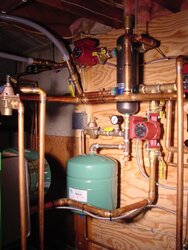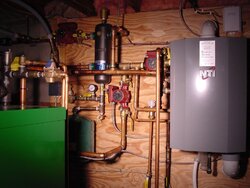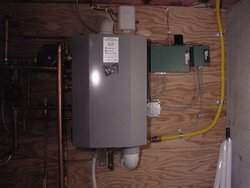Figured I'd post some photos of a recent install. The wood boiler is a certain green-colored model that I no longer sell. The gas (LP) boiler is an NTI Trinity Ti150C.
The wall that this is mounted on was formerly a sliding door in the walkout basement. Since there were two, and this one had a damaged pane, the owner removed the door, allowing the wood boiler to be delivered, then constructed the wall which the piping and gas boiler were hung on.
Not pictured is the air handler, off to the left, which replaced the existing 20-year-old gas furnace. Also not pictured is the A/C condenser, outside. There is also a second air handler in an another attached building, which is where the pex pipes go.
The two green Taco boxes in the first picture interface the zones and boilers. The larger is a zone-valve-control which interfaces the thermostats with the zone valves, and the zone pump. The smaller is a single-zone switching relay which controls the wood boiler pump. The small black box on top of the ZVC is a simple relay which isolates the Trinity's 5-volt controls from the Taco 24-volt controls. It also has a second set of contacts which the owner can wire to a lamp in the house - when the Trinity is being used for a heat demand (meaning the wood boiler is not, the lamp would light, telling the owner that the wood boiler needs more wood.
The small white box over the Trinity is an equipment interface module for the Honeywell IAQ thermostat. The thermostat controls heating, cooling, humidification, dehumidification, and can also control fresh-air ventilation, if needed (for modern, "tight" construction). The wall-mounted thermostat is connected to the EIM by only three wires, and they communicate serially. The EIM has ten wires in this system connecting it to the various components (heat signal to the ZVC, hum, dehum, two stages of cooling, and two extras which could be used for a vent in the future). Not having to snake ten wires through the wall makes life much easier. The EIM also has an outdoor sensor, allowing the thermostat to display outdoor temp, and allowing it to modify the humidification operation as the temperature changes, preventing window frosting.
In the third (DSC01361) picture, the piping is easier to see. The top-left pump sends water to the zones. The small black boxes to the extreme left of that (hard to see, in this picture) are the zone valves, which control where the water goes. The pump immediately next to the Trinity serves it, and the lower pump serves the wood boiler. The black cylinder in the top-center is a hydraulic separator. It prevents the cycling of the zone pump from interfering with the boiler pumps. It also includes an air separator and a sediment separator, in the same unit.
The second (DSC01360) picture shows the piping from a different angle, and the zone valve at the top-left is easier to see in this one. The large flat object at the lower-left is the flat plate heat exchanger which separates the wood boiler (10PSI water pressure) from the gas boiler (20PSI water pressure). The two pressures required two separate feed valves and two expansion tanks (green cylinders).
The plywood on the wall in the lower-left (with the dark shadow on it) used to support an old Aquastar tankless water heater, which has been replaced by the Trinity's domestic water system (internal to the boiler case).
Joe Brown
Brownian Heating Technology
www.brownianheating.com
The wall that this is mounted on was formerly a sliding door in the walkout basement. Since there were two, and this one had a damaged pane, the owner removed the door, allowing the wood boiler to be delivered, then constructed the wall which the piping and gas boiler were hung on.
Not pictured is the air handler, off to the left, which replaced the existing 20-year-old gas furnace. Also not pictured is the A/C condenser, outside. There is also a second air handler in an another attached building, which is where the pex pipes go.
The two green Taco boxes in the first picture interface the zones and boilers. The larger is a zone-valve-control which interfaces the thermostats with the zone valves, and the zone pump. The smaller is a single-zone switching relay which controls the wood boiler pump. The small black box on top of the ZVC is a simple relay which isolates the Trinity's 5-volt controls from the Taco 24-volt controls. It also has a second set of contacts which the owner can wire to a lamp in the house - when the Trinity is being used for a heat demand (meaning the wood boiler is not, the lamp would light, telling the owner that the wood boiler needs more wood.
The small white box over the Trinity is an equipment interface module for the Honeywell IAQ thermostat. The thermostat controls heating, cooling, humidification, dehumidification, and can also control fresh-air ventilation, if needed (for modern, "tight" construction). The wall-mounted thermostat is connected to the EIM by only three wires, and they communicate serially. The EIM has ten wires in this system connecting it to the various components (heat signal to the ZVC, hum, dehum, two stages of cooling, and two extras which could be used for a vent in the future). Not having to snake ten wires through the wall makes life much easier. The EIM also has an outdoor sensor, allowing the thermostat to display outdoor temp, and allowing it to modify the humidification operation as the temperature changes, preventing window frosting.
In the third (DSC01361) picture, the piping is easier to see. The top-left pump sends water to the zones. The small black boxes to the extreme left of that (hard to see, in this picture) are the zone valves, which control where the water goes. The pump immediately next to the Trinity serves it, and the lower pump serves the wood boiler. The black cylinder in the top-center is a hydraulic separator. It prevents the cycling of the zone pump from interfering with the boiler pumps. It also includes an air separator and a sediment separator, in the same unit.
The second (DSC01360) picture shows the piping from a different angle, and the zone valve at the top-left is easier to see in this one. The large flat object at the lower-left is the flat plate heat exchanger which separates the wood boiler (10PSI water pressure) from the gas boiler (20PSI water pressure). The two pressures required two separate feed valves and two expansion tanks (green cylinders).
The plywood on the wall in the lower-left (with the dark shadow on it) used to support an old Aquastar tankless water heater, which has been replaced by the Trinity's domestic water system (internal to the boiler case).
Joe Brown
Brownian Heating Technology
www.brownianheating.com




